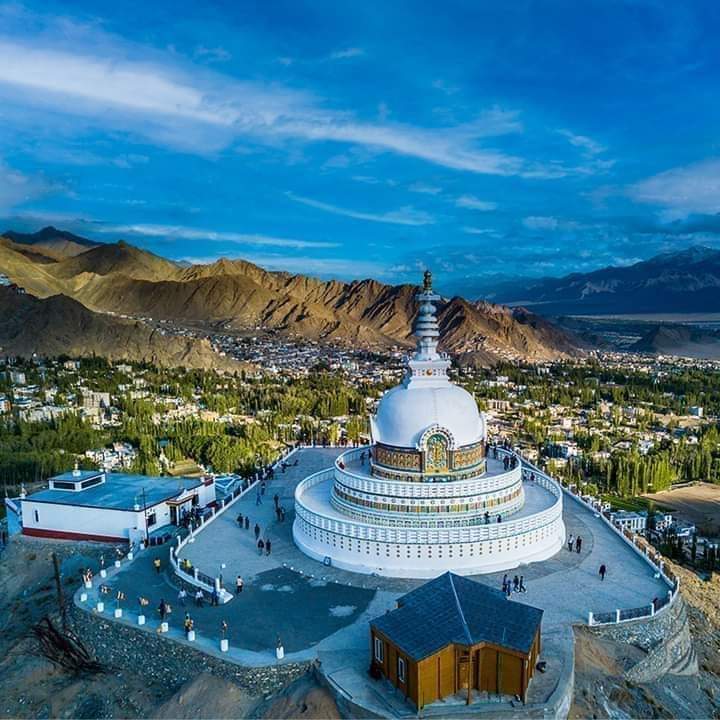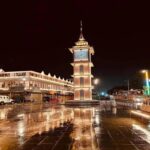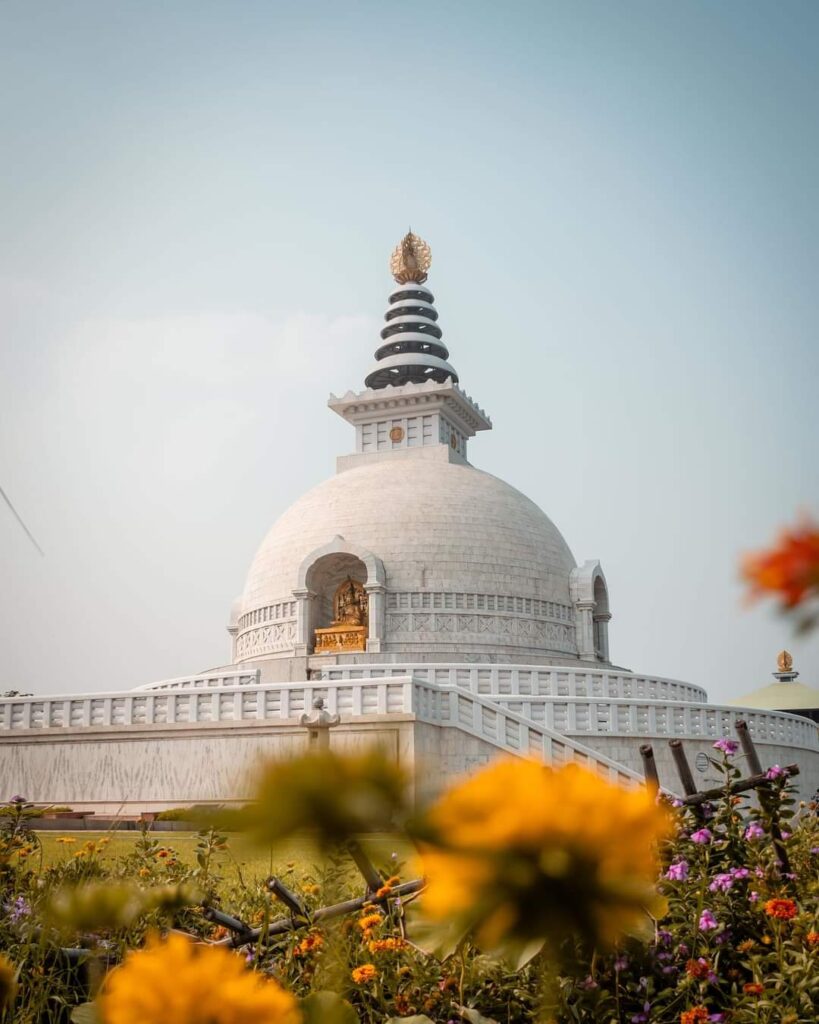
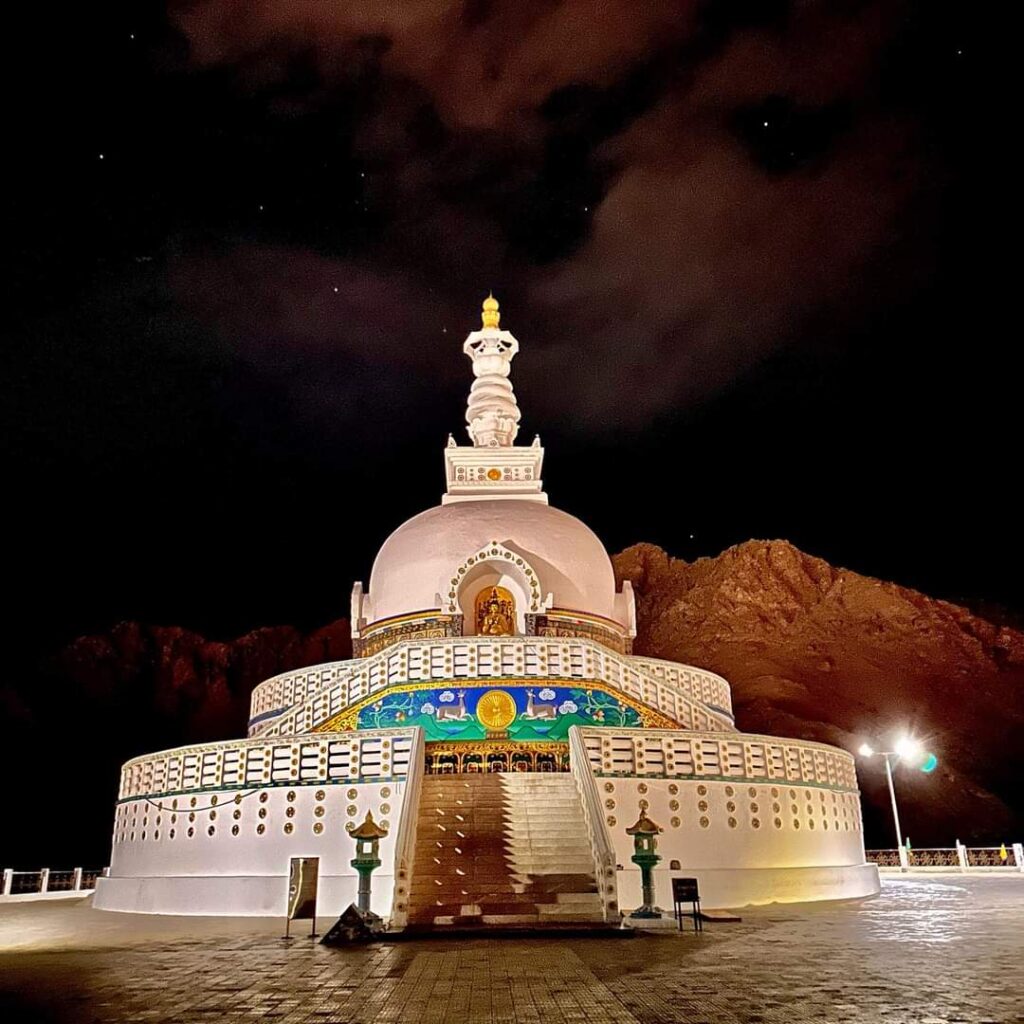
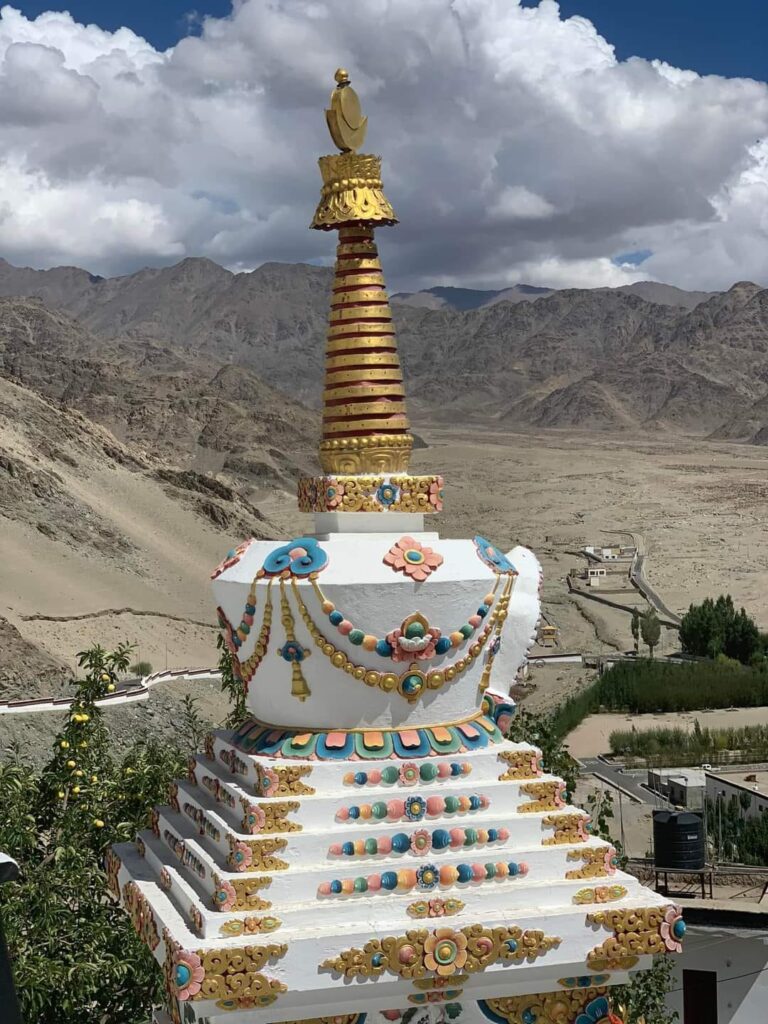
Shanti Stupa
The Shanti Stupa, perched on a hilltop in Ladakh-Leh facing the enchanting Leh Town , A Glorious White Buddhist Stupa Peace Icon. Shanti Stupa, built in 1991, is a gift from Japanese people to Ladakhi people and stands for common values of peace and compassion between these two countries.
The Shanti Stupa is an exceptional masterpiece comprising of two levels having ornate carvings, and vibrant wall paintings illustrating the life and teachings of Buddha. The base of the stupa is where a reliquary holding the revered remains of Buddha lies, having been enshrined personally by the 14th Dalai Lama.
However, Shanti Stupa is not just merely a religious monument. The mountain is also an important tourism site with stunning panoramic scenery of mountains covered in white snow and rolling valleys underneath. At the top of the Stupa one finds a flight of steps which leads up to the summit while one could also take a walk round base for appreciating the beautiful engravings and paintings.
The Shanti Stupa is not only significant for its religious and cultural dimensions but also contributes towards promoting peace and tranquility within the area. It is an area where all people, irrespective of their faith can gather in order to pray for peace and to learn the Buddhist principles of love and comprehension.
The history and significance of the Shanti Stupa
The Story of Shanti Stupa in Ladakh Is One of Peace and Harmony. It was constructed in 1991 by a group of Japanese Buddhist monks under the leadership of Gyomyo Nakamura. Nakmura was a Japanese Buddhism monk moved under the teaching of Lord Budda peace and harmony in the world.
When Nakamura visited Ladakh in 1983, he found it beautiful and Peaceful. This led him to resolve to construct a peaceful stupa at Ladak. The creation of this stupa involved contribution from members of the local Ladakhi community, and it was blessed by his Holiness, the XIVth Dalai Lama, when it was consecrated in 1991.
The Shanti Stupa is a unique structure consisting of two tiers-the upper one ornamented with exquisite sculptures and vivid paintings illustrating the life and preachings of Buddha on every facet of its walls. A reliquary that contains the sacred relics of the Buddha sits at the base of the stupa and was even put in place personally by the 14th Dalai Lama.
In this respect, Shanti Stupa is now one of tourist attraction that offers magnificent view of snow-capped mountains valley around it on Panchanshalimikha hills! The way up is through staircase and one may also take a leisurely walk round the bottom enjoying beautiful carvings and paintings.
The Shanti Stupa also has a very important role in promoting peace and harmony as well as in its religious and cultural importance in the region. It is a place where everyone who wishes can join up in prayer for peace and learning about the principles of peaceful coexistence with neighbors, as taught by Buddhism.
Similarly, many important events have occurred at the Shanti Stupa too. The Shanti Stupa was also visited by the 14th Dalai Lama in 2003, while he provided a presentation on the same. The Shanti Stupa was acknowledged by UNESCO in 2012 as a World Heritage Site.
The Shanti Stupa is an unusual and significant monument which acts as the emblem of peace and amity in Ladakh, the region. This is a place where individuals from different countries meet to pray for peace, to learn about the Buddhism teachings of love and respect.
The Shanti Stupa in Leh, Ladakh is a significant Buddhist monument and a popular tourist destination. It was built in 1991 to promote world peace and prosperity, and to commemorate the 2500th anniversary of Buddhism. The stupa is a two-tiered structure, with each level adorned with intricate carvings and colorful murals depicting the life and teachings of Buddha.
The Shanti Stupa is significant for a number of reasons:
- It is a symbol of peace and harmony. The stupa was built to promote world peace and prosperity, and it serves as a reminder of the shared values of peace and compassion that bind people of all faiths together.
- It is a sacred Buddhist monument. The Shanti Stupa enshrines the relics of Buddha himself, and it is a place where Buddhists can come to pray and learn about the teachings of Buddha.
- It is a popular tourist destination. The Shanti Stupa offers breathtaking panoramic views of the surrounding snow-capped mountains and valleys, and it is a popular destination for tourists from all over the world.
- It is a place for spiritual reflection. The Shanti Stupa is a peaceful and serene place where people of all faiths can come to reflect on the meaning of life and to find inner peace.
Architecture and Symbolism of the Shanti Stupa
The Shanti Stupa is an impressive structure with its two storied sanctuary ornamentally carved and painted with vibrant frescoes portraying the life and teachings of Buddha. Both the beauty of its architecture and the symbolism of the Stupas reveal many things about the Buddhist beliefs of peace, loving kindness, and wisdom.
It comprises of a stupa, constructed in the Buddhist tradition, where the mind is symbolized by a hemispherical form referred to as the stupa. The spire on top of the stupa symbolizes the enlightenment of the Buddha.
At the base stage of the stupa, one can identify a central relief of the Dharmachakra. The Dharmachakra is an emblem of Buddha’s teachings and signifies the way to enlightenment. There are two deer on either side of the wheel of Law; they stand for Sariputta and Moggalana—the first converts of the Buddha.
At the second level, there is an array of bas-relief carvings showing scenes and lessons from Buddha’s life. In these reliefs we see scenes of Buddha’s Birth, Enlightenment and Passing away. These illustrations are also among the Buddhas most popular teachings like the four noble truths and the eight- folded path.
The Shanti Stupa is also decorated with a variety of other symbols, including:
- The lotus flower: Lotus Flower- Symbol of Purity and Enlightenment. In Buddhist art it usually symbolizes the Buddha’s teaching.
- The elephant: Elephants symbolize strength, wisdom, and fortune. In the representation of Buddha’s triumph over ignorance and negative forces, it is often used in Buddhist paintings.
- The lion: Lion means courage and strength. It frequently appears in Buddhist art as a symbol of the Buddha’s guardianship over his disciples.
- The umbrella: Umukobi is an emblem of both royalty and safeguarding. The image used for the Buddha’s teachings in Buddhist is usually the lotus. Being a potent symbol of peace, compassion, and wisdom; Shanti Stupa. People from different religions visit this place so as to pray for peace and have a chance to understand the teachings of the Buddha.
Symbolism of the Shanti Stupa
- The Shanti Stupa represents peace, love and intelligence. The flag also represents the friendship between the nations of Japan and India.
- The white of the stupa signifies purity and tranquility. The stupa’s two levels represent the two paths to enlightenment: Wisdom and Compassions paths.
- The dharmachakra at the base of the stupa signifies the teachings of the Buddha. The Dhamachakra is composed four Noble Truths with the eight fold path.
- The two deer depicted beside the Dharmachakra symbolize the first followers of the Buddha. Deer too are a sign of peace and meekness.
- On the second tier, there are numerous reliefs illustrating the life of Buddha and his teaching. This reminds us about the kindness and wisdom of Buddha.
- The Shanti Stupa is a place where people of all faiths can come together to pray for peace and to learn about the Buddhist teachings. It is a symbol of hope and harmony in a troubled world.
The Shanti Stupa is a place where people of all faiths can come together to pray for peace and to learn about the Buddhist teachings. It is a symbol of hope and harmony in a troubled world.
The religious and cultural significance of the stupa
The Ladakh’s Shanti stupa is a Religious cum cultural important budhist stupa.
Religious significance
Accordingly, Buddhists think that stupa enshrines the relics of the Buddha or some other significant religious personages. There are some sources suggesting that among the remains found at Shanti Stupa there were the relics of the Buddha himself. The fact that the stupa is such a sacred place for Buddhists attracts pilgrims from far and wide who want to pay homage to it.
Besides being said to have positive energy; stupas also contain relics. According to Buddha’s followers, visiting a stupa leads to peace, happiness and luck by a miracle. For instance, it serves as an icon of peace and unity among people of Ladakh, in particular, other Buddhists.
Cultural significance
The Shanti Stupa is also of great cultural significance to the people of Ladakh. Stupas have been built in Ladakh for centuries, and they are an important part of the region’s Buddhist heritage. The Shanti Stupa is one of the largest and most impressive stupas in Ladakh, and it is a popular tourist destination.
The Shanti Stupa is also a symbol of peace and harmony in Ladakh. The stupa was built by Japanese Buddhist monks, and it is a gift from the Japanese people to the people of Ladakh. The stupa is a reminder of the shared values of peace and compassion that bind the two cultures together.
The Shanti Stupa is a place where people of all faiths can come together to pray for peace and to learn about the Buddhist teachings of compassion and understanding. The stupa is a symbol of hope and harmony in a region that has often been ravaged by conflict.
Here are some examples of how the Shanti Stupa is used in religious and cultural practices:
- Buddhists from all over the world come to the Shanti Stupa to pray for peace and to learn about the Buddhist teachings of compassion and understanding.
- The stupa is a popular pilgrimage site for Buddhists from Ladakh, as it is seen as a symbol of peace and harmony in the region.
- The stupa is also a popular tourist destination, and it is a great place to learn about the Buddhist culture of Ladakh.
- The Shanti Stupa is often used as a venue for Buddhist festivals and ceremonies.
- The stupa is also a place where people of all faiths can come together to pray for peace and to learn about the Buddhist teachings of compassion and understanding.
Shanti Stupa is an important religious and cultural center in Ladakh. It is a place where people of all faiths can come together to pray for peace and learn the Buddhist teachings of compassion and understanding.
The Shanti Stupa as a symbol of peace and harmony
Located in the heart of the High Himalayas, the Shanti Stupa is a shining white symbol of peace and harmony. Built in 1991, this Buddhist stupa is a gift from the Japanese to the people of Ladakh, a reminder of the shared values of peace and compassion that unite the two cultures
The Shanti Stupa is a two-storey structure, decorated on each side with intricate paintings and colorful paintings depicting the life and teachings of the Buddha At the foot of the stupa is the sacred relic of the Buddha by the 14th Dalai Lama was himself placed at the foot of the stupa.
Shanti Stupa is not just a religious monument. It is a strong symbol of peace and unity in a region often marred by conflict. A stupa is a place where people of all faiths can come together to pray for peace and learn the Buddhist teachings of compassion and understanding.
The Shanti Stupa is also a popular tourist attraction, offering panoramic views of the surrounding snow-capped mountains and hills. Visitors can climb a flight of stairs to the top of the stupa, or take a leisurely stroll around the base to admire the stunning carvings and paintings
As you climb the steps to the top of the stupa, you can feel the stress and anxiety of the world fade away. When you reach the top, you are greeted with a sense of peace and quiet. The air is filled with the chanting of monks and the ringing of prayer bells.
From the top of the stupa you can see for miles in all directions. Snow-capped mountains rise gracefully in the distance, while countryside forms the hills below. It’s a really awesome thing.
The Peace Stupa reminds us that there is always hope for peace and harmony even in the most troubled parts of the world. It is a place where people of all faiths can come together to pray for peace and learn the importance of compassion and understanding.
Here is a specific example of how the Shanti Stupa symbolizes peace and harmony:
- The stupa is located on a hilltop overlooking Leh in Ladakh, a region historically divided by religious and ethnic conflicts The presence of the stupa is a reminder that people of all faiths can live together in peace and harmony.
- A stupa is a place where people of all faiths can come together to pray for peace and learn the Buddhist teachings of compassion and understanding. The openness and inclusivity of the stupa is a symbol of peace and harmony.
- The stupa is also a popular tourist attraction, attracting visitors from all over the world. The fact that people from different cultures and backgrounds can come together to see the stupa and its message of peace is a testament to its universal appeal.
- The Peace Stupa is a potent symbol of peace and harmony in a world often divided by strife and conflict. It is a reminder that it is possible for people of all faiths and backgrounds to live together in peace and harmony.
Conclusion
The Shanti Stupa is a beacon of peace and harmony in a region often ravaged by conflict. It is a place where people of all faiths can come together to pray for peace and learn the Buddhist teachings of compassion and understanding.
The Peace Stupa is also a reminder of the peace, compassion and shared values that unite people of different cultures It is a symbol of hope for a better future, and a place where we can all work together to create a more peaceful and peaceful world
Conclusion Shanti Stupa is a place of great religious and cultural significance. This is a place where we can all come together and learn the importance of peace, compassion and understanding. It is also a place where we can hope for a better future.
Discover the Magic of Kashmir’s Natural Beauty in Our New Blog – An Adventure You Can’t Miss! THIKSEY MONASTERY , LEH ~ LADAKH
